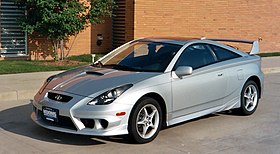This article needs additional citations for verification. (August 2024) |
| Toyota Celica | |
|---|---|
 2004 Toyota Celica GT-S with Action Package body kit (ZZT231, USA) | |
| Overview | |
| Manufacturer | Toyota |
| Production | December 1970[1] – April 2006[2] |
| Model years | 1971–2006 |
| Assembly | Japan: Toyota, Aichi (Tsutsumi plant); Tahara, Aichi (Tahara plant); Susono, Shizuoka (Higashi-Fuji plant) |
| Body and chassis | |
| Class | Sports car |
| Body style |
|
| Layout |
|
The Toyota Celica (/ˈsɛlɪkə/ or /sɛˈliːkə/) (Japanese: トヨタ・セリカ, Hepburn: Toyota Serika) is an automobile produced by Toyota from 1970 until 2006. The Celica name derives from the Latin word coelica meaning heavenly or celestial.[3] In Japan, the Celica was exclusive to Toyota Corolla Store dealer chain. Produced across seven generations, the Celica was powered by various four-cylinder engines, and body styles included convertibles, liftbacks,[4] and notchback coupé.[5]
In 1973, Toyota coined the term liftback to describe the Celica fastback hatchback, and used the name Liftback GT for the North American market.[6][7][8] Like the Ford Mustang, the Celica concept was to attach a coupe body to the chassis and mechanicals from a high volume sedan, in this case the Toyota Carina.[9]
The first three generations of North American market Celicas were powered by variants of Toyota's R series engine. In August 1985, the car's drive layout was changed from rear-wheel drive to front-wheel drive, and all-wheel drive turbocharged models were manufactured from October 1986 to June 1999. Variable valve timing came in certain Japanese models starting from December 1997 and became standard in all models from the 2000 model year. In 1986, the six-cylinder Celica Supra variant was spun off as a separate model, becoming simply the Supra. Lightly altered versions of the Celica were also sold through as the Corona Coupé through the Toyopet dealer network from 1985 to 1989, and as the Toyota Curren through the Vista network from 1994 to 1998.
- ^ Toyota Vehicle Identification Manual. Japan: Toyota Motor Corporation – Overseas Parts Department. 1984. Catalog No.97913-84. Archived from the original on 2015-02-27. Retrieved 2010-05-26.
- ^ "Affiliates (Toyota wholly-owned subsidiaries)-Toyota Motor East Japan, Inc". Toyota. 2012. Archived from the original on 2019-10-28. Retrieved 2022-03-04.
- ^ "What do the different Toyota model names mean?". Toyota Global Site. Archived from the original on 20 January 2018. Retrieved 30 December 2020.
- ^ "Toyota Celica liftback". 75 Years of Toyota. Toyota Motor Corporation. Retrieved 15 June 2024.
- ^ "Toyota Celica coupe". 75 Years of Toyota. Toyota Motor Corporation. Retrieved 15 June 2024.
- ^ Sobran, Alex (2017-05-15). "This Toyota Celica Liftback GT Beautifully Couples Japanese And American Design". Petrolicious (U.S.). Archived from the original on 2023-01-27. Retrieved 2020-09-07.
- ^ Koch, Jeff (2016-01-01). "1971-'77 Toyota Celica". Hemmings Motor News (U.S.). Archived from the original on 2023-04-22. Retrieved 2020-09-07.
- ^ Fets, Jim (2010-12-03). "Collectible Classic: 1976-1977 Toyota Celica GT Liftback". Automobile Magazine (U.S.). Archived from the original on 2021-01-28. Retrieved 2020-09-07.
- ^ Cite error: The named reference
CelicaCarina75was invoked but never defined (see the help page).